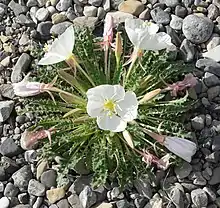| Oenothera caespitosa | |
|---|---|
 | |
| Oenothera caespitosa var. marginata | |
| Scientific classification | |
| Kingdom: | Plantae |
| Clade: | Tracheophytes |
| Clade: | Angiosperms |
| Clade: | Eudicots |
| Clade: | Rosids |
| Order: | Myrtales |
| Family: | Onagraceae |
| Genus: | Oenothera |
| Species: | O. caespitosa |
| Binomial name | |
| Oenothera caespitosa | |

Oenothera caespitosa, known commonly as tufted evening primrose, desert evening primrose, rock-rose evening primrose, or fragrant evening primrose, is a perennial plant of the genus Oenothera native to much of western and central North America, in habitats such as talus slopes and sandy plains.[1] It is normally night-blooming.[2]
The plant is considered good for rock gardens. There are many subtaxa, referred to as subspecies or varieties.
Description
Oenothera caespitosa grows to 10 centimeters (4 inches) tall. It produces a rosette of lobed or toothed leaves each up to 36 centimetres (14 in) long around a woody caudex. It has no stems, with flowers and leaves growing directly from the root crown.[1] The four-petaled white flowers open at dusk and wilt the next morning, turning pink.[3] The petals measure up to 5 cm (2 in) in width and length.[1] A notch gives them a heart shape.[1]
Ecology
The plant is a larval host to the white-lined sphinx moth.[4]
Oenothera caespitosa is dependent on hawkmoths, including the five-spotted hawkmoth (Manduca quinquemaculata) for pollination.[5]
Similar species
Oenothera deltoides is very similar, with short stems and slightly smaller flowers.[1]
References
- 1 2 3 4 5 Taylor, Ronald J. (1994) [1992]. Sagebrush Country: A Wildflower Sanctuary (rev. ed.). Missoula, MT: Mountain Press Pub. Co. p. 46. ISBN 0-87842-280-3. OCLC 25708726.
- ↑ The Xerces Society (2016), Gardening for Butterflies: How You Can Attract and Protect Beautiful, Beneficial Insects, Timber Press.
- ↑ "Botanica. The Illustrated AZ of over 10000 garden plants and how to cultivate them", p. 612. Könemann, 2004. ISBN 3-8331-1253-0
- ↑ The Xerces Society (2016), Gardening for Butterflies: How You Can Attract and Protect Beautiful, Beneficial Insects, Timber Press.
- ↑ Hodges, Scott A. "Some preliminary Observations on Hawkmoth Pollination of Oenothera caespitosa and Mirabilis multiflora" (PDF): 244–249.
{{cite journal}}: Cite journal requires|journal=(help)
External links